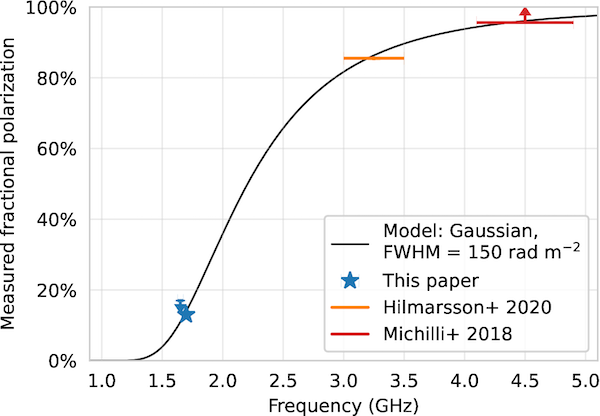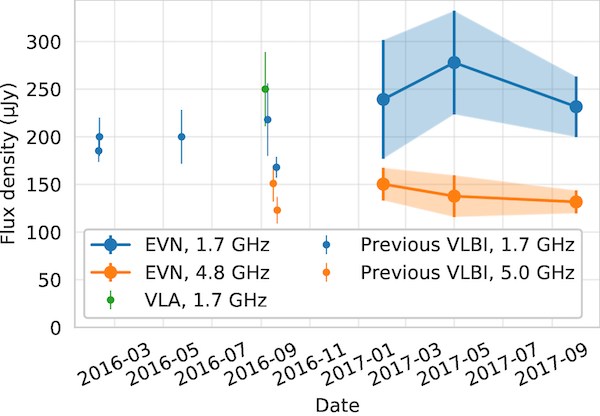
FRB 121102: drastic changes in the burst polarisation contrasts with the stability of the persistent emission
by A. V. Plavin (Astro Space Centre of Lebedev Physical Institute, Russia), Z. Paragi (Joint Institute for VLBI ERIC), B. Marcote (Joint Institute for VLBI ERIC, the Netherlands), A. Keimpema (Joint Institute for VLBI ERIC, the Netherlands), J. W. T. Hessels (ASTRON, The Netherlands Institute for Radio Astronomy, Anton Pannekoek Institute for Astronomy, University of Amsterdam, the Netherlands), K. Nimmo (ASTRON, The Netherlands Institute for Radio Astronomy, Anton Pannekoek Institute for Astronomy, University of Amsterdam, the Netherlands), H. K. Vedantham (ASTRON, The Netherlands Institute for Radio Astronomy, the Netherlands), L. G. Spitler (Max-Planck-Institut fur Radioastronomie, Germany)

phenomenological model assumes 100% intrinsic polarisation with an effective width of 150 rad/m2 in the
RM space. This model is consistent with our measurements at 1.7 GHz and with higher 3-5 GHz measurements.
Fast radio bursts (FRBs) are bright millisecond-duration transients of an extragalactic origin. A great number of theories has been developed to explain this phenomenon in the past decade, many of those invoking neutron stars. Some FRBs are repeating, making it possible to organise detailed follow-up observations that include interferometers, so that to probe the emission regions with extreme resolution and sensitivity.
FRB 121102 is the first repeater discovered, and its properties make the source unique among FRBs. It lies within a star-forming region of a dwarf galaxy at a redshift of 0.19. The high rotation measure (RM) exceeding 105 rad/m2 indicates dense highly magnetised plasma around the emitter. This plasma is likely related to the persistent radio source colocated with the bursts. The persistent source also has multiple alternative explanations, including an AGN or a young nebula. More focused studies of the source properties on milliarcsecond scales, and its relation to the bursts RM, would let us constrain all these models better. In Plavin et al. (2022), we present such studies, including both EVN and single-dish observations, and discuss the results.
The brightest burst of FRB 121102 within the observation campaign was caught on 20 September 2016. Thanks to the VLBI backend at Effelsberg, we managed to reanalyse the data at the highest spectral resolution of 4 kHz; this became crucial for the polarisation studies. We detected a significant linear polarisation of FRB 121102 bursts for the first time at a low frequency of 1.7 GHz. The rotation measure was the highest to date at 1.27 x 105 rad/m2, qualitatively consistent with the falling trend on the years timescales. Linear polarisation fraction turned out to be much lower at 1.7 GHz: only 15%, compared to almost 100% observed at 5 GHz. This low fraction, combined with the requirement of a high spectral resolution, is the likely reason why no burst polarisation was detected at 1-2 GHz before. We explain this striking difference between frequencies with minor non-uniformities in the screen, leading to spatial depolarization: the emission Faraday width of just 150 rad/m2, or 0.1% of the total RM, is enough.

measurements in 2017 are shown in comparison with earlier VLA, VLBA, and EVN
observations. Variability within each frequency band is insignificant and lies below 10%.
Our dedicated EVN observations throughout 2017 caught no bursts, but this dataset provides invaluable information about the persistent radio counterpart. The observations included more telescopes than previous studies, leading to a better spatial frequency coverage and a higher sensitivity. The radio source flux density is only 0.2 mJy, so we used both a regular phase-referencing calibrator, and a secondary in-beam one for relative comparisons. As it turns out, the persistent emission is surprisingly stable: flux variations are less than 10% over a year; the apparent position stays the same up to 0.1 mas, and is consistent between 1.7 and 4.8 GHz. The upper limits on the source size of 1 pc further constrains the maximal potential expansion rate to ~104 km/s. The lack of variations in observed parameters of the persistent emission, combined with changes in the bursts rate and their RM, put strong constraints on models explaining the environment of FRB 121102. For example, an expanding supernova would show a decaying luminosity trend; an AGN could have frequency-dependent apparent positions, or a general flux variability; a nebula inflated by a magnetar outflow would lead to a correlation between the burst rate and the persistent emission.
Unique and dedicated observations of FRB 121102 performed by the EVN and the Effelsberg telescope lead to these results we present in Plavin et al. (2022). More observations, including polarisation, simultaneously at a wide frequency range and consistently over multiple years, would further help understanding the FRB environment evolution and the mechanisms underlying the bursting and persistent emission.
Published in Plavin et al. 2022, MNRAS, 511, 4, 6033–6041